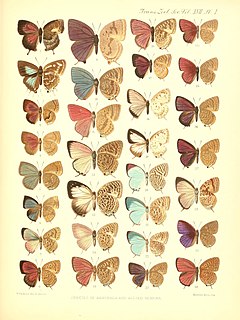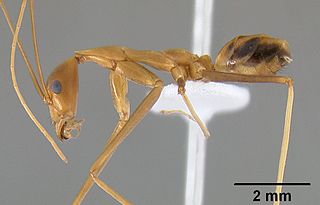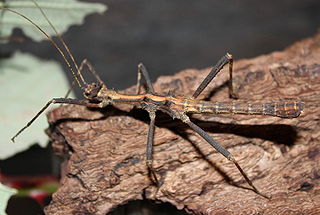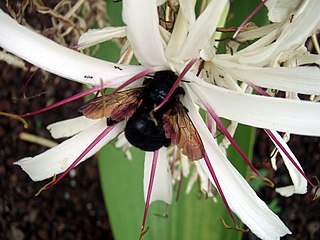 W
WApis nigrocincta is a species of honey bee that inhabits the Philippine island of Mindanao as well as the Indonesian islands of Sangihe and Sulawesi. The species is known to have queens with the highest mating frequencies of any species of the tribe Apini.
 W
WArhopala alexandrae is a butterfly in the family Lycaenidae. It was described by Schröder & Treadaway in 1978. It is endemic to the Philippines in the Indomalayan realm.
 W
WDesmidophorus cumingi is a species of weevil in the family Brachyceridae. This beetle can reach a length of about 12 mm. It occurs in the Philippines.
 W
WLeptomyrmex fragilis is a species of ant in the genus Leptomyrmex. Described by Smith in 1859, the species is endemic to Indonesia and New Guinea and the Philippines.
 W
WMelanothrix nymphaliaria is a moth in the family Eupterotidae. It was described by Francis Walker in 1866. It is found on Java, Sumatra and Borneo and possibly also in the Philippines. The habitat consists of lowland forests.
 W
WObenbergerula is a genus of beetles in the family Buprestidae, the jewel beetles. They are native to the Philippines. These beetles reach well over a centimeter in length and are brightly colored, usually shades of iridescent green with large spots. Their coloration is thought to be mimetic, possibly in mimicry of jewel bugs.
 W
WOrthetrum serapia, the green skimmer, is a freshwater dragonfly in the family Libellulidae. The serapia species is present in Australia, the Philippines, Fiji, Papua New Guinea and Solomon Islands. It inhabits a wide range of still and sluggish waters, often shallow. In Australia it ranges from the top end of the Northern Territory to about Mackay in central Queensland.
 W
WOrthetrum testaceum, common names Crimson Dropwing or Orange Skimmer. is an Asian freshwater dragonfly species belonging to the family Libellulidae.
 W
WPachyrhynchus argus is a species weevil in the family Curculionidae. It is a small black weevil, with blue-green rings on the elytra. This species can be found in Philippines.
 W
WPachyrhynchus reticulatus is a species weevil in the family Curculionidae. This species can be found in Philippines, Luzon, Marinduque.
 W
WPachyrhynchus smaragdinus is a species of primitive weevil in the family Curculionidae.
 W
WPhyllium bilobatum is a species of leaf insect in the family Phylliidae. It is found in the Philippines and Malaysia. This species was first described in 1843 by the English zoologist George Robert Gray, who gave it the name Phyllium bilobatum. It has been assigned to the subgenus Phyllium, which is to be distinguished from the second subgenus Pulchriphyllium, within the genus Phyllium. The holotype is a female from the Philippines, which is kept in the Natural History Museum, London where Gray worked cataloguing insects.
 W
WThe seashore earwig is a species of earwig in the family Anisolabididae. It is native to eastern Australia and New Zealand. Similar both ecologically and taxonomically to the maritime earwig, this species is commonly found on beaches under stones and debris. It is a carnivore, feeding on millipedes, flies, and isopods such as woodlice. Like most other earwigs, the females care for their young during development, and the larva go through five instars before becoming adults. The species also has a negative phototaxis, meaning that it tends to move away from a light source. The species was first described in 1846 by Adam White.
 W
WSungaya inexpectata is a species of stick insect. Its common name is the sunny stick insect, derived from the less commonly used sungay stick insect. It is a species in the order of the stick insects Phasmatodea and the only member of the genus Sungaya. The genus name refers to the locality of the holotype, i.e. the region where the insect was first identified. The species name is derived from the Latin as "inexpectatus" and means "unexpected".
 W
WTenodera angustipennis is a species of mantis native to Asia and nearby areas of Oceania. The species was introduced and became established in the eastern United States. Tenodera angustipennis was noticed as early as 1921 in Aberdeen, Maryland, but that occurrence was not noted in a published record until 1933.
 W
WTricondyla aptera is a beetle species in the family of Carabidae. This species is found in Australia, Indonesia, Philippines, Papua New Guinea, and Solomon Islands.
 W
WTrigonopterus palawanensis is a species of flightless weevil in the genus Trigonopterus from the Philippines.
 W
WXylocopa sonorina, the valley carpenter bee or Hawaiian carpenter bee, is a species of carpenter bee found from western Texas to northern California, and the eastern Pacific islands. Females are black while males are golden-brown with green eyes.